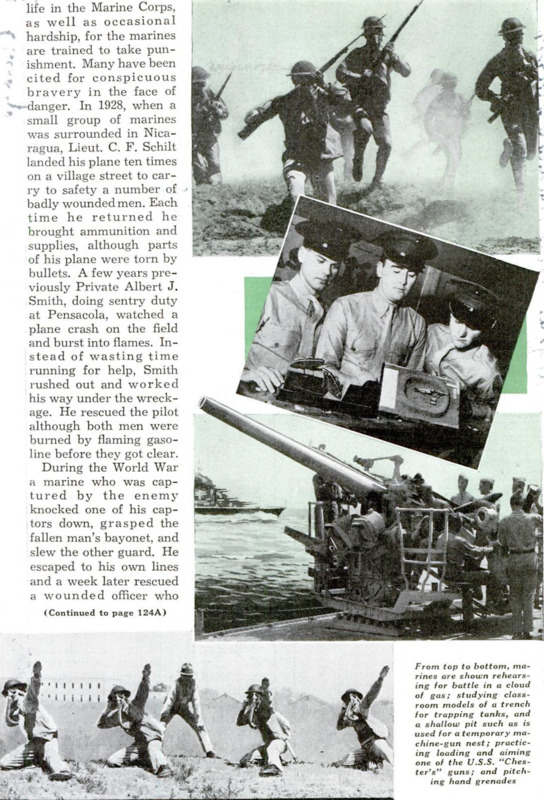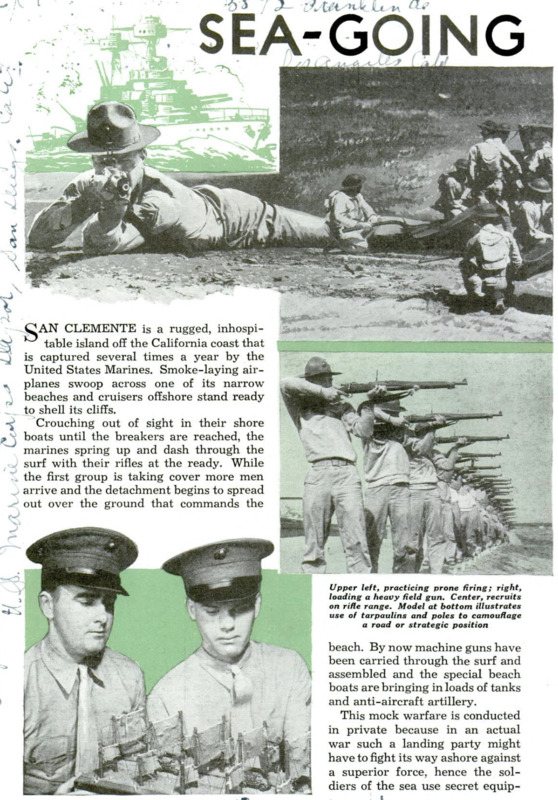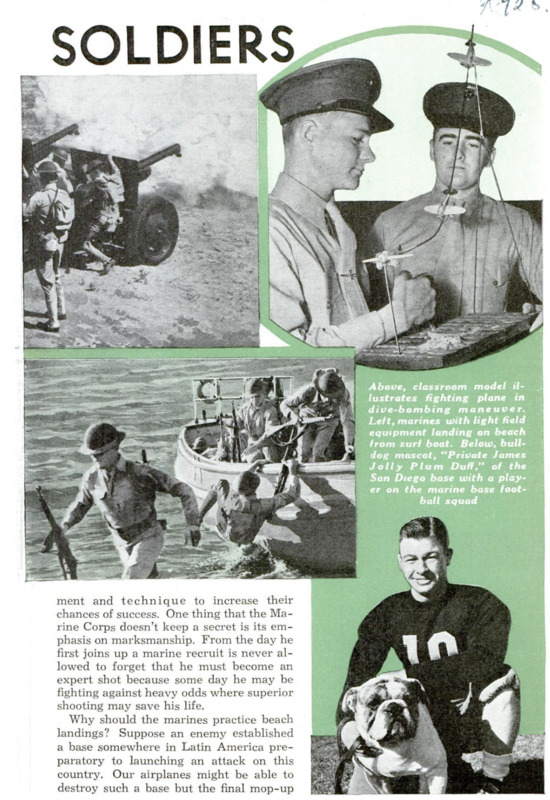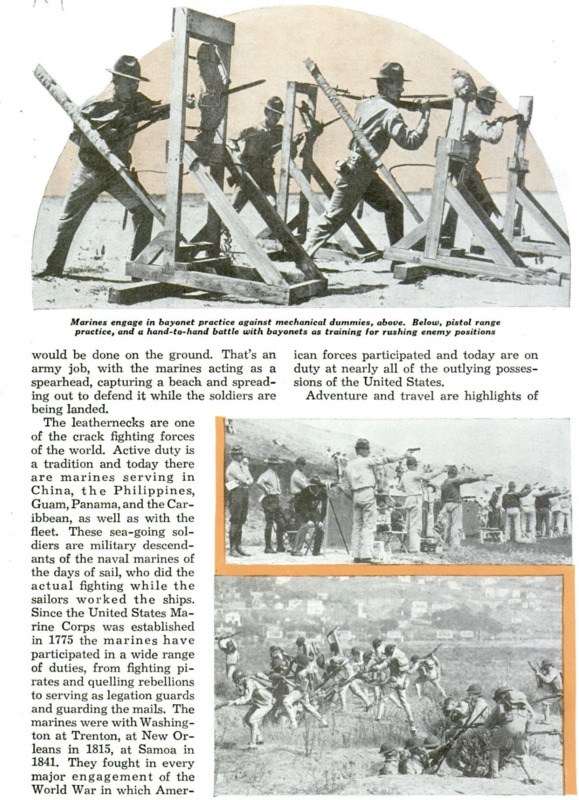SAN CLEMENTE is a rugged, inhospitable island off the California coast that is captured several times a year by the United States Marines, Smoke-laying airplanes swoop across one of its marrow beaches and cruisers offshore stand ready to shell its cliffs. Crouching out of sight in their shore boats until the breakers are reached, the marines spring up and dash through the surf with their rifles at the ready. While the first group is taking cover more men arrive and the detachment begins to spread out over the ground that commands the beach. By now machine guns have been carried through the surf and assembled and the special beach boats are bringing in loads of tanks and anti-aircraft artillery. This mock warfare is conducted in private because in an actual war such a landing party might have to fight its way ashore against a superior force, hence the soldiers of the sea use secret equipment and technique to increase their chances of success. One thing that the Marine Corps doesn’t keep a secret is its emphasis on marksmanship. From the day he first joins up a marine recruit is never allowed to forget that he must become an expert shot because some day he may be fighting against heavy odds where superior shooting may save his life. Why should the marines practice beach landings? Suppose an enemy established a base somewhere in Latin America preparatory to launching an attack on this country. Our airplanes might be able to destroy such a base but the final mop-up would be done on the ground. That's an army job, with the marines acting as a spearhead, capturing a beach and spreading out to defend it while the soldiers are being landed. The leathernecks are one of the crack fighting forces of the world. Active duty is a tradition and today there are marines serving in China, the Philippines, Guam, Panama, and the Caribbean, as well as with the fleet. These sea-going soldiers are military descendants of the naval marines of the days of sail, who did the actual fighting while the sailors worked the ships. Since the United States Marine Corps was established in 1775 the marines have participated in a wide range of duties, from fighting pirates and quelling rebellions to serving as legation guards and guarding the mails. The marines were with Washington at Trenton, at New Orleans in 1815, at Samoa in 1841, They fought in every major engagement of the World War in which Amer- ican forces participated and today are on duty at nearly all of the outlying possessions of the United States. Adventure and travel are highlights of life in the Marine Corps, as well as occasional hardship, for the marines are trained to take punishment. Many have been cited for conspicuous bravery in the face of danger. In 1928, when a small group of marines was surrounded in Nicaragua, Lieut. C. F. Schilt landed his plane ten times on a village street to carry to safety a number of badly wounded men. Each time he returned he brought ammunition and supplies, although parts of his plane were torn by bullets. A few years previously Private Albert J. Smith, doing sentry duty at Pensacola, watched a plane crash on the field and burst into flames. Instead of wasting time running for help, Smith rushed out and worked his way under the wreckage. He rescued the pilot although both men were burned by flaming gasoline before they got clear. During the World War a marine who was captured by the enemy knocked one of his captors down, grasped the fallen man’s bayonet, and slew the other guard. He escaped to his own lines and a week later rescued a wounded officer who had been surrounded by six Germans. Another marine in the World War, single-handed, attacked two machine-gun emplacements, captured their crews, and then took forty more prisoners from a dugout. The Marine Corps is a comparatively small force and only recently was its authorized strength raised to 34,000 men. It is organized like an army but it is part of the navy. Detachments up to sixty-five men serve on battleships, heavy cruisers, and aircraft carriers. On board ship they man several of the secondary batteries, some of the searchlights, and fly some of the airplanes. Their other duties are to make landings and in case of a major expedition to make up the initial striking force that lands and contacts the enemy. Each marine is a picked man, proud of the fighting traditions of the corps. Because of their amphibious nature even the marines who do sea duty spend some of their time ashore. They sleep in tents in the field, fire machine guns and artillery, and learn to swarm across rough country. A marine airplane pilot may spend a year being shot from a battleship’s catapult and the next year picking his way in and out of small fields in a tropical jungle. The requirements for joining the Marines are similar to those of the navy. As a rule an applicant must be between eighteen and twenty-five, althoughsmen with unusual qualifications may be accepted up to the age of thirty. Applicants must be unmarried citizens, in good health, and of good moral character. They sign up for four years, with a starting pay of twenty-one dollars per month. Increases are possible up to a top pay of $157 per month. After his initial training a young marine is assigned to one of the seven branches of the service for which he shows aptitude. These divisions are musicians, signal and radio, quartermaster, line, paymaster, aviation, and mess. Recruits east of the Mississippi are sent to Parris Island, S. C,, for_training and those from the west to San Diego. At either school a recruit spends the first three weeks in the drills and studies of an infantryman. He does setting-up exercises, bayonet drill, learns to wear a gas mask and throw hand grenades, the new extended order drill, and how to handle a rifle. He listens to lectures on scouting and patrol duty, use of a compass, and chemical warfare. He attends sound motion pictures that teach first aid, musketry, and other military subjects. He spends the next three weeks on the shooting range with the service revolver, rifle, and automatic weapons. Finally, he spends another week back at the training depot. Out of each group, the fifteen per cent who receive the highest marks in this training period then spend an additional three weeks at sea school and are then assigned to the fleet. The others are shipped to schools for specialized instruction, to duty at navy yards, or to outlying bases. The corps operates schools in photography, aerography, aviation, radio, field telephony, fire control, optics, and kindred subjects. In addition, numerous correspondence courses are offered free by the Marine Corps Institute. Enlisted marines who are properly qualified may compete for enrollment at Annapolis. Men who desire aviation training are usually assigned to the aviation branch of the Marine Corps although the number who can be given flight training is restricted. One way of getting into Marine Corps aviation is to join the Marine Corps Reserve instead of the Corps itself. Reserve cadets spend a year at Pensacola after a thirty-day primary instruction period and are then commissioned as second lieutenants in the reserve and are ordered to four vears active duty with aircraft squadrons. Like their brothers in arms afloat and ashore, marines are constantly studying, drilling and practicing. The result is that the armed forces of the United States are better prepared to resist an enemy than the public might suppose. Enlistments are increasing and modern weapons are being provided. The American military machine is known the world over for its fighting spirit, which in the last analysis is the intangible factor that wins battles.








